Physical Address
304 North Cardinal St.
Dorchester Center, MA 02124
Physical Address
304 North Cardinal St.
Dorchester Center, MA 02124
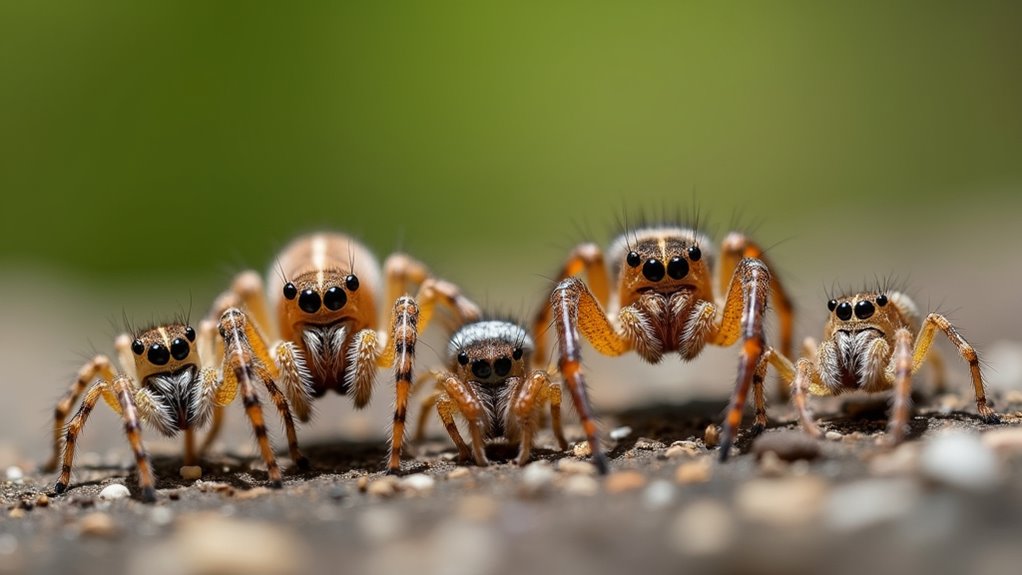
Beware of Italy's eight-legged residents – from harmless orbweavers to potentially dangerous violin spiders lurking in unexpected places.
In Italy, you’ll encounter spiders like the Cross Orbweaver (with distinctive white cross markings), the dangerous Violin Spider (with its violin-shaped mark), the Florentine Segestria (with metallic green fangs), and the Common Combtailed Spider. Most Italian spiders are harmless, but knowing how to identify the Mediterranean Recluse and Malmignatta (Black Widow-like) is essential for safety. These arachnids inhabit various environments from urban parks to coastal regions. Let’s explore what makes each species unique.
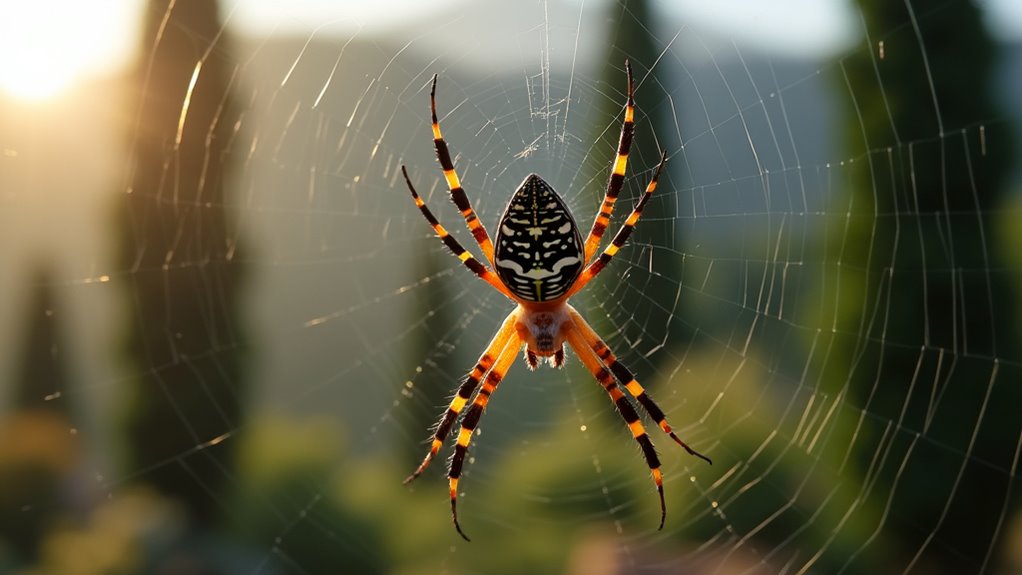
While strolling through Italian gardens in late summer, you’ll likely encounter the Cross Orbweaver (Araneus diadematus), one of the most recognizable arachnids in the country. You’ll spot these spiders by their distinctive white cross markings on a body that ranges from light yellow to dark brown.
The Cross Orbweaver graces Italian gardens with its distinctive white cross, a sentinel in yellow to brown attire.
These skilled architects create magnificent orb-shaped webs up to 60 cm in diameter, where they hang head-down waiting for prey. Females are significantly larger than males, measuring between 6.5 and 20mm in length.
Don’t worry if you see one – their bite is mild and poses no threat to humans. They’re actually beneficial, controlling pesky insects like flies and mosquitoes. If visiting Naples with family, you might spot these harmless creatures in gardens of family-friendly hotels throughout the city.
The female’s life cycle ends after producing silk-covered egg sacs in autumn. Come spring, hundreds of spiderlings will emerge and balloon away on silken threads, starting the cycle anew.
Unlike the garden-friendly Cross Orbweaver, Italy harbors a more concerning arachnid you should be aware of: the Violin Spider (Loxosceles rufescens), also known as the Mediterranean Recluse.
This invasive species gets its name from the distinctive violin-shaped mark on its back. Adults typically measure between 7-12mm with females being larger than males and having broader abdomens. You’ll typically find these spiders hiding in dark, secluded areas like basements, caves, and tunnels across both urban and rural Italy. While exploring the beautiful island of Capri, be especially cautious in ancient ruins and cave structures where these spiders may dwell.
What makes them particularly dangerous is their venom, which can cause severe skin necrosis.
If you encounter this six-eyed spider, remember:
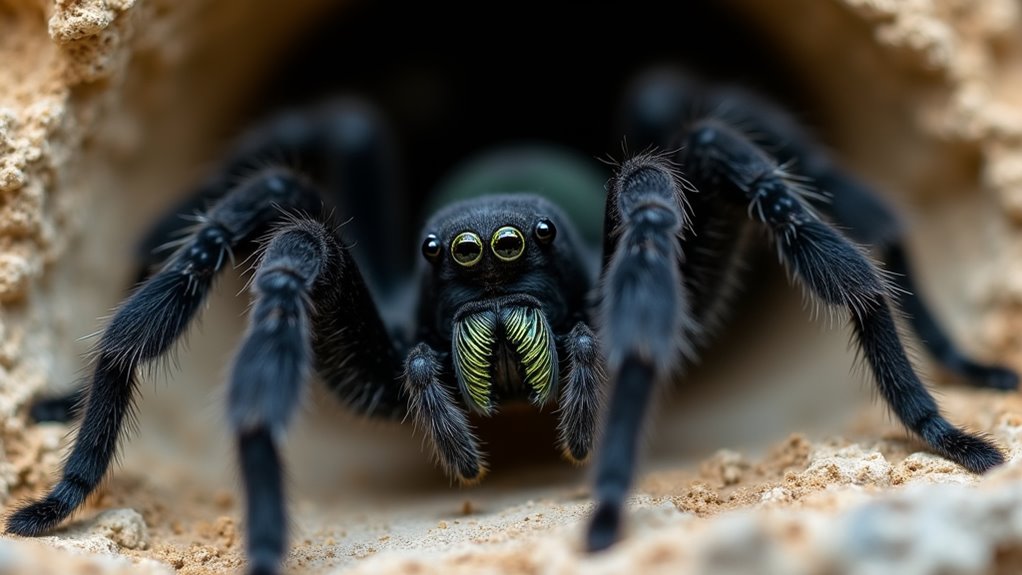
The Florentine Segestria stands as the largest tube-web spider in Europe, immediately recognizable by its metallic green fangs that shimmer against its dark body. You’ll typically find these impressive spiders, with females reaching 22mm in length, inhabiting cracks in old walls and brickwork throughout Italy.
These nocturnal hunters create silk-lined tubes with radiating tripwires that alert them to passing prey. Their silk-lined tubes serve as both protective retreats and efficient hunting grounds. When their silk lines detect vibrations, they’ll burst from their retreat with remarkable speed, front three pairs of legs extended forward.
While their bite is painful, it’s not medically significant. You’ll rarely encounter them unless you’re disturbing their retreats.
Look for their distinctive cylindrical silk tubes in urban structures, particularly in Mediterranean regions and port towns where these specialized predators thrive. They’re a common species throughout Italy’s diverse ecosystems, from coastal areas to urban environments.
Italy’s Common Combtailed Spider, scientifically known as Iberina montana, represents one of the more discreet arachnids you’ll encounter across the country. These small spiders often go unnoticed as they build their delicate sheet-like webs in protected spots among vegetation and moss. These spiders are distinguished by their spinnerets in row arrangement, resembling a comb-like structure.
You’ll find these solitary creatures adapting to various microclimates throughout Italy, where they contribute to natural pest control by capturing small insects. Tourists exploring Milan and other Italian cities can observe these fascinating arachnids with complete safety as they aren’t harmful to humans.
During spring and summer, females produce egg sacs to protect their developing offspring.
When searching for Iberina montana, keep in mind:
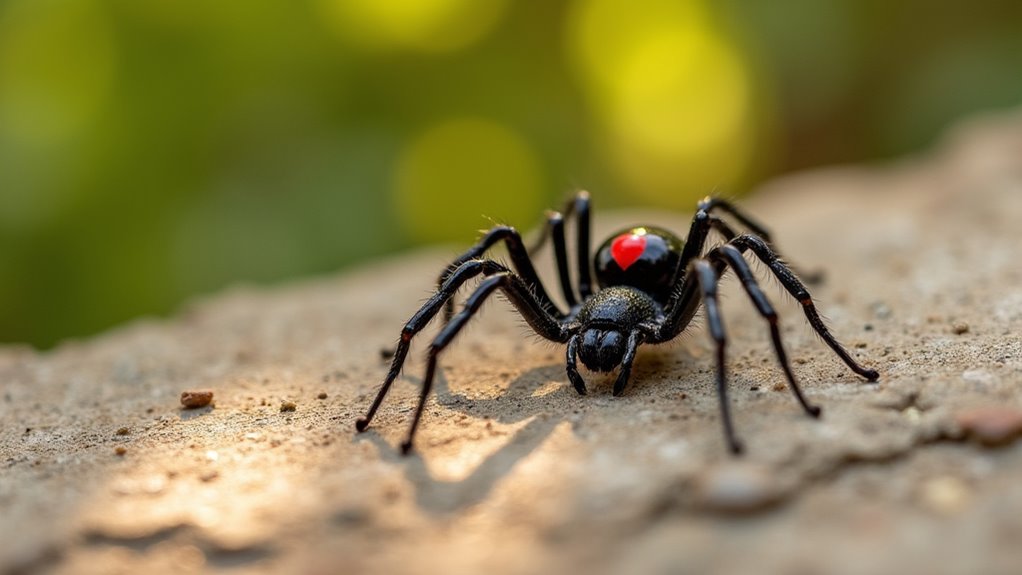
While most spiders you’ll encounter in Italy are harmless like the Common Combtailed Spider, distinguishing dangerous species from benign ones requires understanding their venom composition and effects.
Most Italian spiders pose little threat, but knowing venom characteristics helps identify the few dangerous species.
The most medically significant spider in Italy is the Loxosceles rufescens (violin spider), whose venom contains phospholipases D that can cause dermonecrotic lesions. If bitten, you might experience local swelling, redness, and in rare cases, systemic reactions like fever and increased heart rate.
Yellow sac spiders (Cheiracanthium) are also present but generally pose less risk. Their bites typically cause only minor local reactions. The Malmignatta (Latrodectus tredecimguttatus), also known as the black Mediterranean Widow, inhabits dry areas and can deliver bites causing muscle pain and cramps that develop within 24 hours. Whether you’re exploring the busy streets of Naples or Sorrento, remain vigilant as spiders can be found throughout Italy’s diverse regions.
Remember that serious envenomations are rare in Italy, and most spider bites resolve without medical intervention. However, if you develop severe symptoms or a spreading necrotic lesion, seek immediate medical attention as supportive care may be necessary.
Across Italy’s diverse landscapes, you’ll find spiders inhabiting a remarkable variety of environments, from sun-drenched olive groves in Central Italy to humid urban parks in Rome. The Mediterranean climate creates perfect conditions for diverse arachnid populations, with distinct regional variations throughout the country.
If you’re looking to observe these fascinating creatures in their natural habitats, here are key regions and environments to explore:
When traveling between regions to spot different spider species, consider using Italy’s extensive train network which provides convenient access to both major cities and rural countryside areas.
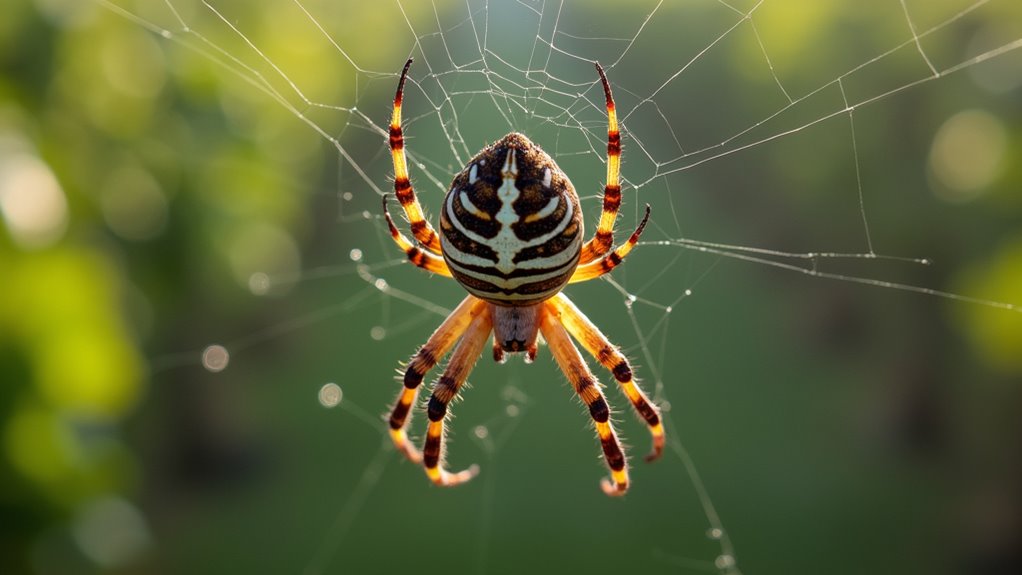
When encountering spiders in Italy’s diverse habitats, knowing how to identify them helps both appreciation and safety. Look for distinctive traits like the Cross Orbweaver’s light yellow to dark grey body with white cross-shaped markings, or the Mediterranean recluse‘s violin-like pattern on its cephalothorax.
Size offers clues too—Cross Orbweavers reach up to 20mm for females, while common house spiders stay smaller at 5-10mm. Wolf spiders can exceed 25mm and don’t build webs, unlike orbweavers with their classic spiral designs. The Malmignatta spider can be identified by its black body with thirteen red spots on the abdomen, primarily found on females. Unlike the venomous snakes of Italy, most spider species pose little threat to humans when left undisturbed.
Behavior further distinguishes species: orbweavers hang inverted at web centers, jumping spiders make agile leaps with their distinctive large eyes, and crab spiders ambush prey by mimicking flower colors, remaining motionless for days.
Now you’re ready to spot Italy’s eight-legged residents with confidence. Remember, while some spiders like the Mediterranean Recluse require caution, most Italian species keep to themselves. Whether you’re hiking in Tuscany or relaxing at your vacation rental, don’t let spider fears get under your skin. With proper identification skills, you’ll appreciate these fascinating creatures from a respectful distance as part of Italy’s diverse biodiversity.